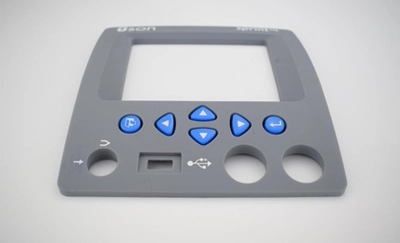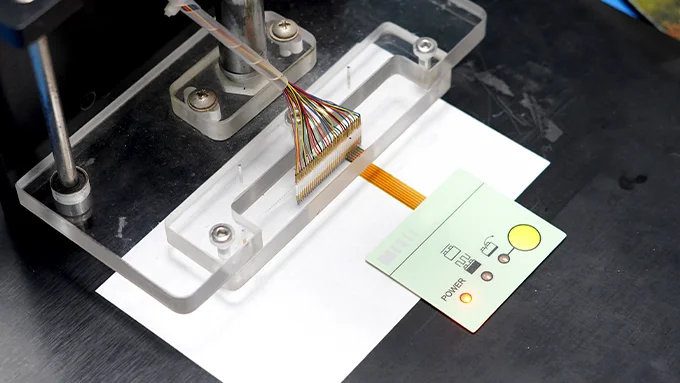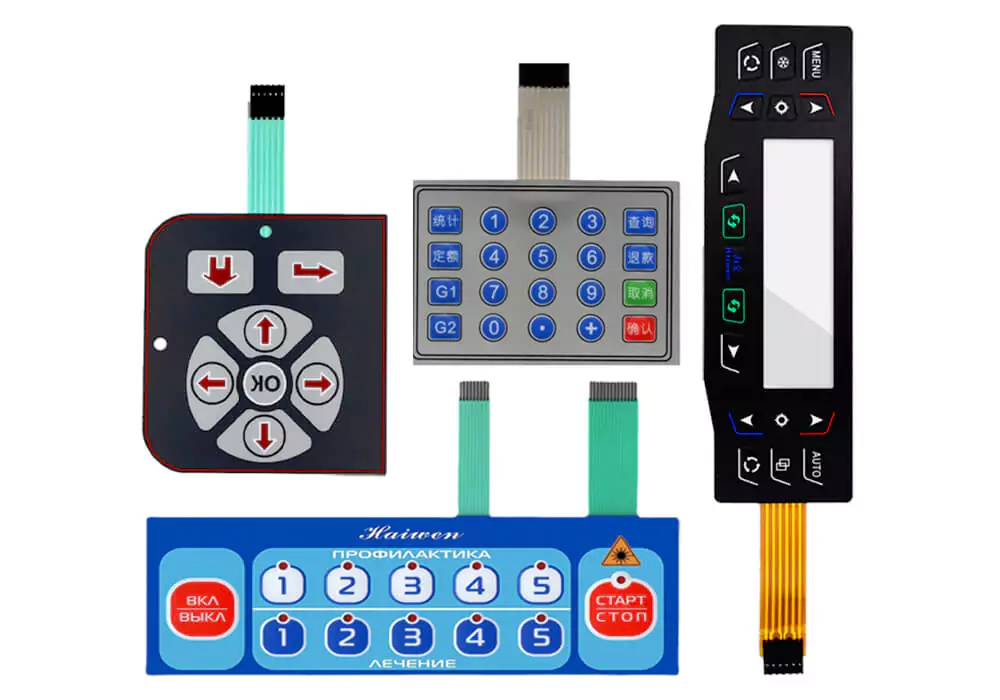How membrane switch drives sustainability in electronic product design
The Production Process Behind Membrane Change: What You Required to Know
The production process behind membrane layer changes combines careful style, material choice, and quality assurance. It starts with recognizing the details of membrane button design and advances with various stages, consisting of material selections and printing strategies. Each phase plays an important function in making certain capability and longevity. The complexities of layer building and the extensive testing standards might reveal insights that are not instantly obvious. What lies beyond these foundational aspects?
Understanding Membrane Change Layout
Although membrane layer switches may show up easy at very first look, their layout includes complex factors to consider that assure performance and toughness. The layout process starts with a comprehensive understanding of customer needs, consisting of the interface's designated application and ecological elements. Comfort designs is a crucial element, as the layout should assist in simplicity of use while guaranteeing that responsive responses satisfies customer expectations.Moreover, the layering of parts, such as visuals overlays, glue layers, and conductive traces, must be precisely engineered. membrane switch. This split setup not only affects the button's responsiveness however also impacts its longevity. Focus is provided to the sealing techniques employed to secure against dampness and dust, which might compromise efficiency. Furthermore, style considerations encompass visual appeals, where color pattern and aesthetic quality boost individual experience. Inevitably, the design of membrane switches balances capability, individual experience, and resilience, guaranteeing that they fulfill the demands of various applications effectively
Products Utilized in Membrane Change Production
When selecting materials for membrane button manufacturing, it is necessary to contemplate both efficiency and durability. The key products include polyester and polycarbonate films, which supply flexibility and strength. These movies are usually covered with sticky to guarantee proper bonding to substratums. Conductive inks, commonly composed of silver or carbon, are important for producing electrical connections within the button, permitting for dependable operation.Additionally, a safety layer, such as a hard coat, is frequently used to boost scratch resistance and durability. The selection of backing material, such as acrylic or foam, can considerably impact the button's responsive feeling and total user experience. Furthermore, various environmental variables, consisting of temperature level and humidity, need to lead material option to ensure peak efficiency in specific applications. Ultimately, the ideal mix of products adds to the membrane layer button's capability and life-span, making informed choices essential for producers.
The Printing Refine: Creating Graphics and Text
The printing process in membrane layer switch production plays a considerable duty in generating top notch graphics and message. Various visuals style methods are utilized to assure aesthetic allure and performance, while cautious ink choice methods are vital for durability and performance. Recognizing these elements is essential for accomplishing best cause membrane layer button design.
Graphic Layout Techniques
Graphic style strategies play a vital duty in the printing procedure of membrane layer buttons, as they define how graphics and message will eventually appear on the final product. Efficient graphic design entails the strategic use of designs, colors, and fonts to improve readability and visual appeal. Developers typically utilize vector graphics for scalability, making sure that images continue to be sharp at various sizes. In addition, attention to comparison and placement is essential, as it affects customer communication and visual quality. The unification of branding elements, such as logos, have to be managed with like preserve brand name honesty. Overall, thoughtful graphic style strategies contribute substantially to the functionality and appearance of membrane layer switches, influencing user experience and item efficiency.
Ink Choice Approaches
Choosing the ideal ink is important for attaining the preferred aesthetic quality and longevity in membrane switch manufacturing. Various ink types are utilized, consisting of solvent-based, water-based, and UV-curable inks. Each type provides distinct features, such as adhesion, resistance, and adaptability to environmental variables. Solvent-based inks are commonly favored for their resilience and vibrant colors, while water-based inks are a lot more eco-friendly yet might have restrictions in bond. UV-curable inks give rapid healing and durable performance. Furthermore, shade matching methods assure that the picked inks straighten with design requirements. Ultimately, the choice of ink have to think about variables such as application method, substrate compatibility, and end-use demands to accomplish remarkable cause membrane button graphics and message.
Layer Building And Construction and Setting Up

Product Choice Refine
A cautious option of materials is essential in the manufacturing process of membrane layer switches, as it straight influences performance and sturdiness. The main products made use of consist of polyester, polycarbonate, and various conductive inks. Polyester is typically favored for its superb resistance to chemicals and abrasion, making it appropriate for extreme environments. Polycarbonate, on the other hand, supplies remarkable clarity and impact resistance, which is beneficial for applications requiring presence and effectiveness. Conductive inks, generally composed of silver or carbon, are important for creating trusted electric pathways. Furthermore, the option of sticky products affects the general integrity of the switch - membrane switch. Reviewing variables such as environmental exposure, tactile responses, and aesthetic needs guides suppliers in picking the very best materials for their specific applications
Layer Attachment Strategies
Adhering layers in membrane layer switch building is a vital process that ensures capability and durability. Numerous adhesion methods are used to safeguard optimal bonding in between layers, which commonly include making use of adhesives, heat, and stress. Pressure-sensitive adhesives (PSAs) are generally utilized for their simplicity of application and prompt bonding abilities. In addition, thermal bonding techniques can be applied, where warm is made use of to trigger sticky residential properties, securing a solid bond. The selection of adhesion approach mostly relies on the products involved and the particular application requirements of the membrane switch. Appropriate positioning and uniform application of adhesives are important to avoid issues, safeguarding the switch runs successfully throughout its designated life expectancy.
High Quality Control Procedures
Guaranteeing quality assurance during the layer building and construction and setting up of membrane buttons is vital for keeping efficiency and integrity. This process commonly includes several crucial steps, consisting of thorough examinations at each phase of production. Suppliers use advanced testing approaches, such as peel tests and attachment click now analyses, to verify the honesty of layer bonds. In addition, visual assessments are carried out to recognize any kind of problems in printing or material inconsistencies. Environmental problems, such as temperature and moisture, are very carefully kept an eye on to guarantee excellent curing and bond. Furthermore, normal calibration of tools aids maintain exact production requirements. By applying these high quality control procedures, producers can greatly lower the threat of product failure, ensuring that the final membrane layer changes fulfill the called for specs and consumer expectations.
Evaluating and Quality Assurance Procedures

Technologies in Membrane Layer Switch Over Modern Technology
As improvements in technology remain to evolve, membrane layer switches are benefiting from innovative growths that boost their performance and individual experience. One remarkable advancement is the integration of capacitive touch innovation, which permits even more receptive and instinctive individual interfaces. This change not only improves looks but also minimizes mechanical damage, expanding the life-span of the switches.Additionally, innovations in graphic overlay products have resulted in enhanced resilience and resistance to ecological factors such as moisture and UV light. These products currently provide improved quality and brightness, more raising the visual appeal.Furthermore, the unification of wise modern technology is changing membrane layer switches over right into interactive control board, making it possible for connectivity with IoT tools. This connectivity fosters a smooth individual experience, leading the way for applications in numerous sectors, from healthcare to customer electronics. Jointly, these innovations position membrane layer changes as important components in contemporary gadget layout.
Often Asked Questions
For how long Does the Membrane Layer Change Manufacturing Process Take?
The period of the membrane button manufacturing process can vary significantly. Aspects such as intricacy, materials made use of, and manufacturing volume impact timelines, with regular manufacturing look these up varying from a few days to numerous weeks for conclusion.
What Are the Common Applications for Membrane Buttons?
Membrane switches are typically utilized in various markets, including automotive controls, household devices, medical tools, and customer electronic devices (membrane switch). Their versatility and resilience make them ideal for applications needing straightforward user interfaces and reputable efficiency in diverse environments
Can Membrane Changes Be Custom-made for Certain Requirements?

What Is the Lifespan of a Typical Membrane Switch Over?
The lifespan of a regular membrane button differs, yet usually, it varies from 1 to 5 million cycles. Factors such as usage, atmosphere, and worldly top quality substantially affect resilience and general efficiency in time.

Are Membrane Switches Ecologically Friendly?
The environmental friendliness of membrane switches varies. Some materials used might not be recyclable, while others can be eco-friendly. The general influence depends upon manufacturing materials and methods, necessitating careful look what i found factor to consider throughout selection and disposal. The production process behind membrane changes combines mindful style, product selection, and high quality control. It begins with comprehending the complexities of membrane button layout and progresses with numerous stages, consisting of product options and printing strategies. When selecting products for membrane switch production, it is necessary to ponder both efficiency and longevity. A mindful choice of materials is vital in the manufacturing process of membrane switches, as it directly influences capability and resilience. The selection of bond approach mostly depends on the products included and the details application demands of the membrane layer switch.